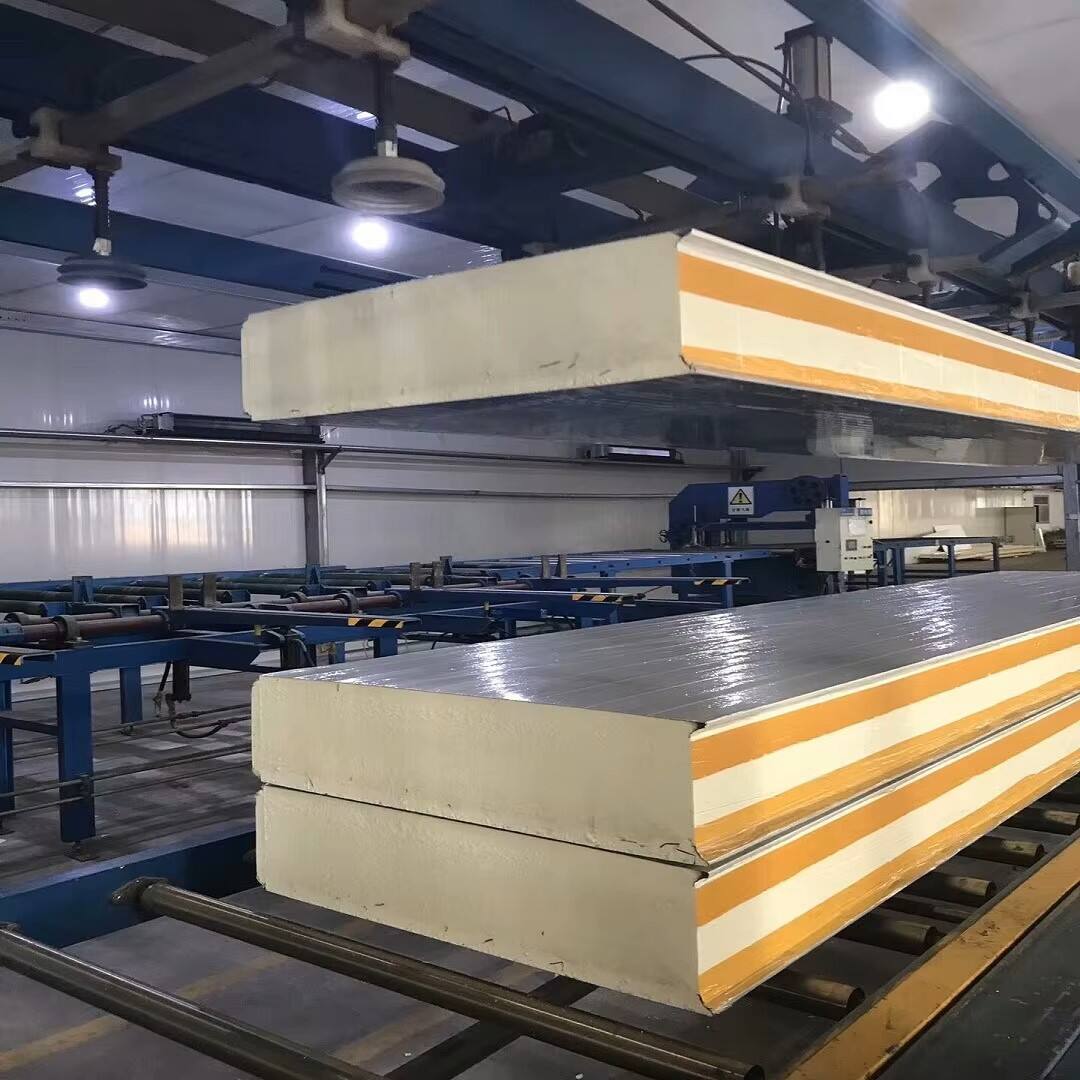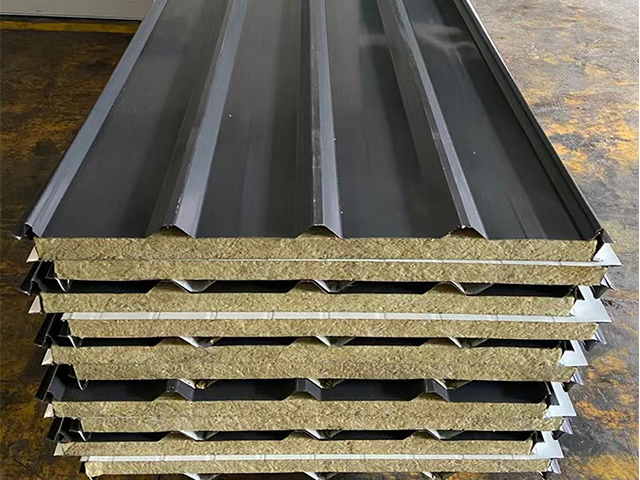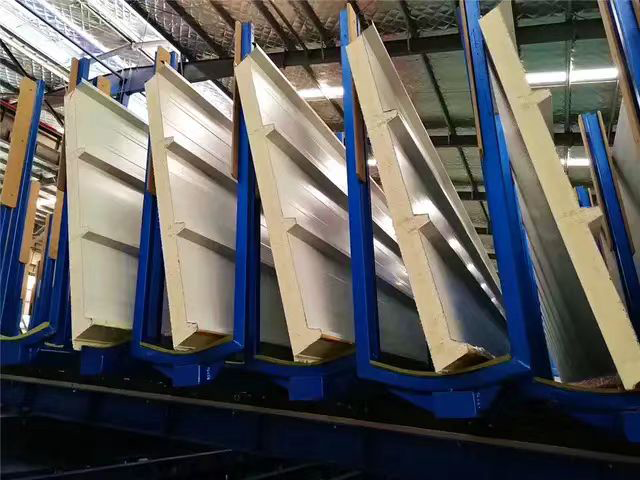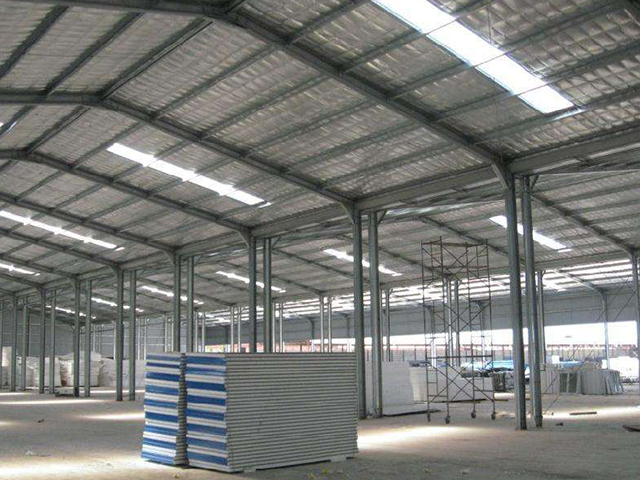Exceptional Thermal Insulation and Energy Efficiency
How PU Core Material Enhances Thermal Resistance in Sandwich Panels
PU sandwich panels offer excellent thermal insulation because of their closed cell core design that holds in inert gases, cutting down heat transfer by around 35% compared to older materials on the market. The way these panels are constructed helps prevent thermal bridging, something that often plagues metal panel systems, since they keep R values pretty steady between roughly 5.7 and 6.5 for each inch thickness. According to recent studies published in Scientific Reports back in 2023, buildings equipped with PU sandwich panels actually need about 18 to maybe even 22 percent less time running refrigeration units to maintain those cold storage temps at minus 18 degrees Celsius when compared against structures using expanded polystyrene insulation instead.
High R-Value Insulation and Its Role in Minimizing Energy Loss
Polyurethane (PU) cores typically reach R-values between 30 and 50 when used in regular cold storage walls. When these values go up by around 10%, refrigerated warehouses tend to cut down their yearly energy usage somewhere between 4% and 6%. The importance of this becomes really apparent in freezers running at minus 30 degrees Celsius. At those temperatures, the difference between inside and outside can be over 50 degrees, which means heating ventilation air conditioning systems start costing about seventeen dollars per square meter each year if there's not enough good insulation installed properly.
Reducing Operational Costs Through Improved Energy Efficiency in Cold Storage
Switching to PU sandwich panels reduces electricity costs by an average of 23%, driven by:
- 34% shorter compressor cycles
- 19% lower defrost frequency
- 12% reduced air infiltration
These improvements translate into faster return on investment, with most facilities recovering insulation upgrade costs through energy savings within 3–5 years.
Case Study: Measurable Energy Savings in Refrigerated Warehouses Using PU Sandwich Panels
A 12,000 m² pharmaceutical storage facility in Sweden achieved a 31% annual energy reduction–dropping from 189 kWh/m² to 130 kWh/m²–after retrofitting walls with 200mm PU sandwich panels. The $740,000 project reached full payback in four years via reduced utility and HVAC maintenance expenses.
Long-Term Cost Benefits of Low Energy Consumption in Temperature-Controlled Environments
Over a 20-year lifecycle, PU-insulated cold rooms incur 44% lower total ownership costs compared to mineral wool systems, due to:
- 62% lower energy expenditure
- 80% fewer moisture-related repairs
- 55% longer equipment lifespan
Facilities also report 23% fewer annual maintenance labor hours compared to those using spray foam or fiberglass insulation.
Superior Moisture Resistance and Vapor Control
Built in vapor barrier properties of PU sandwich panels in high-humidity cold storage
The continuous closed-cell core of PU sandwich panels acts as an integral vapor barrier, eliminating the need for additional membranes. This design meets ASHRAE 160 standards for hygrothermal performance and blocks up to 98% of moisture ingress in sub-zero environments, outperforming traditional insulation that relies on supplemental sealing.
Preventing condensation, mold, and structural damage with waterproof panel design
Seamless, non-absorbent surfaces prevent condensation at panel joints–common sites for microbial growth in refrigerated spaces. Testing indicates an 83% lower risk of mold development compared to fibrous insulations under 85%+ relative humidity. The waterproof nature preserves structural integrity and supports food-grade hygiene standards.
Durability under freeze-thaw cycles and wet operating conditions
Polyurethane sandwich panels can handle well over 300 freeze thaw cycles without showing any cracks or coming apart at the seams, according to tests done following ASTM C1262 standards. When exposed to sudden temperature shifts around 40 degrees Celsius during cleaning processes, these panels expand by less than half of one percent. That kind of minimal movement keeps things stable dimensionally, which matters a lot when looking at how well materials perform over time. All these characteristics mean most installations last somewhere between 35 to 40 years in refrigerated environments where constant temperature fluctuations are part of daily operations.
Structural Strength and Performance in Extreme Cold
Maintaining Structural Integrity Under Constant Low Temperatures
PU sandwich panels retain 95–98% of their compressive strength at -40°C, according to cryogenic testing. The closed-cell structure resists brittle fracture, a common failure mode in conventional materials exposed to prolonged freezing conditions.
Resistance to Warping, Cracking, and Deformation in Cold Room Environments
With thermal expansion coefficients below 60 µm/m·°C, PU panels maintain alignment and joint integrity across 150+ freeze-thaw cycles. This stability prevents stress-induced cracking at connections, avoiding the 23% rise in maintenance costs typically seen in traditional cold room wall systems under high humidity.
Balancing Lightweight Design With Load-Bearing Requirements in Cold Storage Facilities
Despite their light weight 40% lighter than conventional alternatives–PU sandwich panels support roof loads up to 1,500 kg/m². This high strength-to-weight ratio enables cost-efficient vertical expansions and ensures compliance with seismic standards in multi-story refrigerated buildings.
Ease of Installation and Long Term Operational Reliability
Seamless, Corrosion Resistant Surfaces That Reduce Maintenance Needs
Non-porous surfaces resist microbial growth and chemical corrosion, requiring only routine cleaning with mild detergents. Unlike traditional metal-clad rooms, PU panels do not need protective coatings or frequent repairs, reducing long-term maintenance demands.
Lifecycle Advantages of PU Sandwich Panels Over Traditional Insulation Materials
PU cores retain their insulating effectiveness 3–5 times longer than fiberglass or mineral wool, based on industry performance data. This durability cuts replacement costs by 60–70% over 20 years in refrigerated environments.
Streamlined Construction Process: From Panel Design to Cold Room Installation
Prefabricated PU panels with interlocking joints enable installation 40% faster than stick-built methods. Their modular design allows rapid, precise cold room expansions, with case studies showing 3,000 m² facilities completed in 8 working days–compared to 14 days using conventional techniques. Integrated tongue-and-groove systems minimize thermal bridging during assembly, enhancing overall energy performance.
FAQ
What is the thermal efficiency of PU sandwich panels compared to older materials?
PU sandwich panels reduce heat transfer by around 35% compared to older insulation materials, offering high thermal resistance.
How does the use of PU panels affect energy usage in cold storage?
Buildings with PU panels need 18-22% less running time for refrigeration units, leading to reduced energy consumption.
What is the expected lifespan of PU sandwich panels?
PU panels can last between 35 to 40 years in refrigerated environments due to their robust design and resistance to harsh conditions.
How do PU panels help prevent condensation and mold growth?
With a continuous closed-cell core acting as a vapor barrier, PU panels minimize moisture ingress and significantly reduce the risk of mold growth in humid environments.
What are the structural benefits of using PU panels in cold environments?
PU panels retain up to 98% compressive strength at -40°C and resist warping and cracking, ensuring long-term structural integrity in extreme cold.
Table of Contents
-
Exceptional Thermal Insulation and Energy Efficiency
- How PU Core Material Enhances Thermal Resistance in Sandwich Panels
- High R-Value Insulation and Its Role in Minimizing Energy Loss
- Reducing Operational Costs Through Improved Energy Efficiency in Cold Storage
- Case Study: Measurable Energy Savings in Refrigerated Warehouses Using PU Sandwich Panels
- Long-Term Cost Benefits of Low Energy Consumption in Temperature-Controlled Environments
- Superior Moisture Resistance and Vapor Control
- Structural Strength and Performance in Extreme Cold
- Ease of Installation and Long Term Operational Reliability
-
FAQ
- What is the thermal efficiency of PU sandwich panels compared to older materials?
- How does the use of PU panels affect energy usage in cold storage?
- What is the expected lifespan of PU sandwich panels?
- How do PU panels help prevent condensation and mold growth?
- What are the structural benefits of using PU panels in cold environments?






